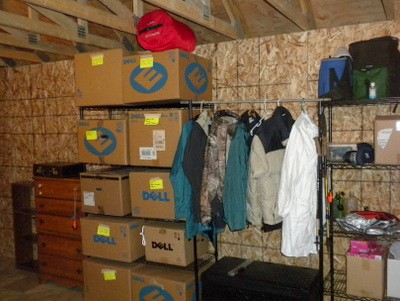Before storing your winter sleeping bag away for 6 months give it an inspection, fluff it up and make sure it is dry. If you need to clean your sleeping bag read the manufacturer’s directions. There is variability between outdoor gear materials and their proper maintenance and repair. If you didn’t hang on to the care instructions that came with your gear (likely) you can check the manufacturer’s website as many manufacturer’s list care instructions online. To wash use only mild soap and wash in a front-loading or commercial machine or by hand (NOT in an top-loading agitator machine or by dry cleaning). Rinse very well and be very careful lifting up a wet sleeping bag; support all of its weight. Tumble dry on low heat (throw in some tennis balls with a down bag). Store your winter sleeping bag loose, not stuffed, in as large a space as possible such as a breathable stuff sack, a large cardboard box or hung. Compressing a sleeping bags crushes down feathers and breaks synthetic fibers, reducing the sleeping bag’s ability to trap air, maintain loft, and keep you warm. Keep compressed sleeping bags away from hot and/or humid spaces as compression combined with heat and humidity will reduce the lifespan of a bag even faster than each alone.
Wash, clean, and treat any clothing, outerwear, and footwear that you’re putting into storage. There are numerous products made to clean and treat specific materials: soft shells, down, wool, hard shells, full-grain leather boots. (Grangers, McNett, and Nikwax, among others all sell cleaning, repair, and treatments products and kits for outdoor gear, with detailed instructions.) Clean your hiking boots and let them dry completely before storing in a closet. Apply durable water repellant (DWR) treatments to waterproof apparel. DWR coatings naturally degrade in sunlight and after frequent use. Signs of reduced DWR performance include condensation build-up, reduced beading of water droplets, and fabric saturation after light rains.
Set up your winter camping tent and clean off excess dirt and debris. Re-apply seam sealer, if necessary. Make sure your tent is fully dry before storing it away.
Make sure your stove is clean and ready to go. Read the manufacturer’s instructions closely. Many stove manufacturers sell repair and maintenance kits for specific stove models. Stoves with pumps may need the pump oiled. Wipe-down gas stoves to remove carbon deposits and food stains; carbon stains can eventually clog the fuel lines and burner pores, causing a stove to sputter.
Don’t leave old fuel in a stove you’re not using regularly. Store stove fuel and pressurized canisters in a garage, basement, or shed separate from the rest of you gear to reduce the risk of leakage, fire, and explosion.
Clean the hard-to-clean spaces of the water bladders and tubes. Uncap water bottles and hydration bladders to open them up to continuous air flow.
Store your battery-powered devices and extra batteries in cool, dry locations; avoid excessive heat which drains unused batteries.
Once it is clean and dry store your gear in its proper place with all of its parts; same for any insulated garments.
Review your supplies. Check first aid kids for outdated medicine and prescriptions, then restock. Restock or replace any gear repair and maintenance kits and survival gear you carry. Check batteries and replace spares.
Make a list to buy supplies like stove fuel, trail maps and guidebooks, favorite meals and snacks now, so you won’t waste time looking for them on your way to the trailhead.
Get organized. Once your gear and supplies are ready for the trail, organize and label the bins in your gear closet/room/storage space, so you can find exactly the gear you need when you need it. That way, you can get out the door quickly, without leaving something essential behind. Update and print out your gear checklists (if you’ve got a laminator, put it to use). Taking the time to clean and organize your gear now can mean better backcountry trips next time out.
Follow our occasional Tweets @WinterCampers and visit us on Facebook.
SHARE
April 7th, 2014 | Tags: Gear | Category: Winter Camping, Winter Camping Gear, Winter Camping Skills
Comments are closed.



